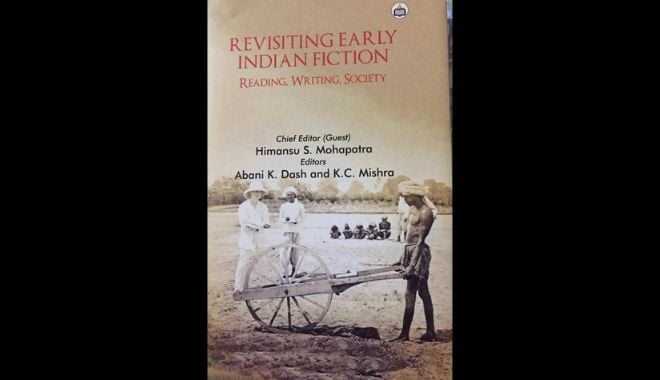A Kaleidoscopic Survey

| Revisiting Early Indian Fiction: Reading, Writing, SocietyEdited by Himansu S. Mohapatra, Abani K. Dash & K.C. Mishra Published in Nov 2020 by Authors Press, New Delhi Pages: 256 Price: Rs1200 |
The second half of the 19th century saw an outburst of ideas in art, culture, science, political thought and social reforms in India. This efflorescence transformed the traditional Indian way of thinking about and handling these crucial spheres of culture and society. No wonder the urge for change touched the creative writers too. Due to their predisposition for experimentation, they lapped up the opportunity with gusto. This renaissance brought about new literary genres, such as the novel and short story, in many Indian languages. The Odia language and literature, passing through the throes of survival and revival during this period, benefitted immensely from the emerging trends of reading, writing and forming world views.
The book under review is the compilation of custom-made essays that seek out the trends that imbue and shape the Indian fiction genre. Aptly titled “Revisiting Early Indian Fiction: Reading Writing, Society”, the book journeys back to the roots of Indian and Odia fiction to show the sway reading and writing held on the early masters. While the ingress of western ideas and forms put winds on their sails, the rich heritage of Indian traditions – ingrained in them for centuries – prodded them to quest for new harbours. Thus reading novels, or just anything, became a leitmotif for many such early stories. Similarly, writing fiction was now open to experimentation in form and content.
Written text as foisted by the colonisers changed the rules of the game and, in turn, the roles associated with the act. Indian society was largely tradition-based and non-textual in its dealings, but no more. Written words lent gravity and permanence to communication, such as in court proceedings and as evidence. Tradition and modernity were now confronting each other, unsure how to react until they decided to synthesise. As many of the essays show, this melding of disparate elements ultimately enriched Indian fiction greatly.
But tradition and modernity were not the only opposing forces that characterised the novel of the period; the instances of co-existing opposites were many. Thus we have colonial ‘rule of writing’ flouting the role that writing is called upon to play; writing also pits national belonging against international longing. In the opening essay ‘The Early Indian Novel and the Rule of Writing’, Bijay K. Danta attributes the duality of early Indian novel to the divisive gaze of a ‘Janus-faced muse’, a reference to the two-faced Roman god. The essay discusses four early novels with reading and writing as their essential principle. It concludes that ‘writing acquires a social life that has a wider significance than just the form.’
During the formative years of the Indian novel, Fakir Mohan Senapati had a colossal presence in Odia fiction, not because of his considerable oeuvre but because his works so subtly captured the blending of Indian and an alien culture. The collection rightfully keeps Senapati’s works in the spotlight, digging into the layers of subtexts he employed to present a world in flux. His works such as “Rebati,” “Aja Nati Katha”, and Mamu are critiqued to bring out the master storyteller’s ambiguous stance towards English and other nuances.
The roles of reading, writing against a backdrop of the social dynamics find a fitting reflection in the novel Basanti (1931) represented in its English translation Basant: Writing the New Woman (OUP, 2019). In the story, the eponymous protagonist’s life takes new turns due to her love for reading and education, which are considered beyond the pale of a married woman at that time. The novel’s writing was also a departure from tradition, written collaboratively by multiple writers, a few of them women. Because of its affinity with the collection’s theme, Basanti gets a look-in in quite a few essays that examine women’s changing face and other social impact of reading and writing in a traditional society. We also have a piece by the book’s translators who lucidly describe the classic’s translation process and how it was received by critics. Similarly, two different essays discuss Padmamali, ‘the first known exemplar of the novel genre in Odia’. While essayist Jagannath Dash tracks the journey from romance to realism, Jyoti Priyadarshini, in her piece, finds secular echoes of mythology as the story celebrates sensuality and ‘unleashing of the element of desire’.
The collection pores over an array of subjects related to novelists who stand wide apart in time and style. Thus we have essays that explore subaltern life in Sadat Hasan Manto’s stories, treatment of Indian sensibility in Raja Rao, the significance of RK Narayan’s tiny fictional universe, and so on. As the above listing would imply, subjects often spill over the stated thematic objective of the collection. It takes the editors’ ingenuity to put them into perspective. Chief Editor Himansu S. Mohapatra and editors Abani K. Dash and KC Mishra have deftly shoehorned the contributions into subcategories that ultimately harmonise with the collection’s objective. The disparate pieces produce a kaleidoscopic symmetry. Mohapatra’s well-written introduction provides a brief look at the essays justifying each one’s place in the scheme of things.
Noted novelist Chandrahas Choudhury in his blurb piece celebrates the pleasures the early novels provided to the readers and the power reading held for transforming minds. In this collection, he discovers an escape route from the digital age’s maddening overabundance of text and images to a time when reading was “precious, difficult, secretive, rapturous, controversial and radical – anything but banal.”
The collection is the end result of an international conference organised by Karanjia Autonomous College in November 2019.

Comments are closed.